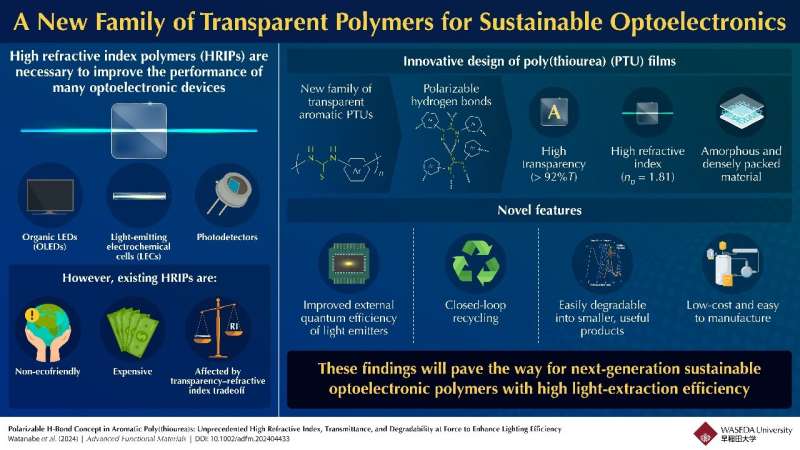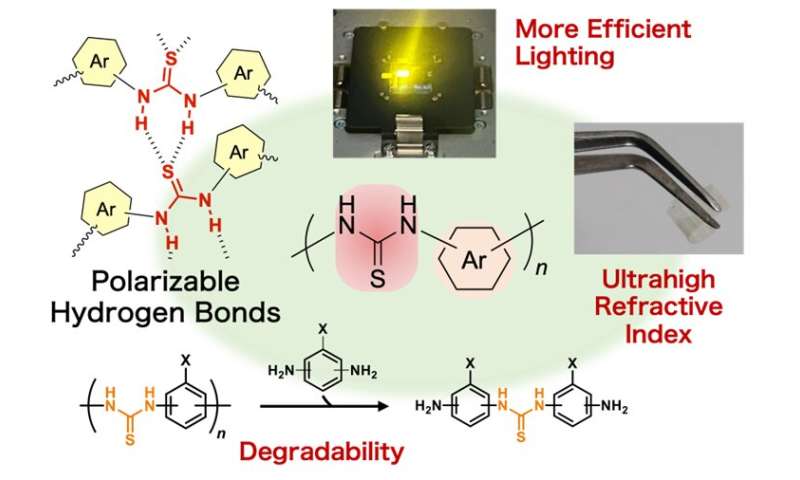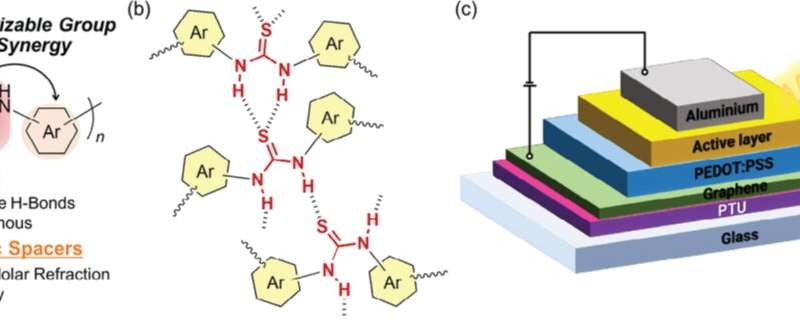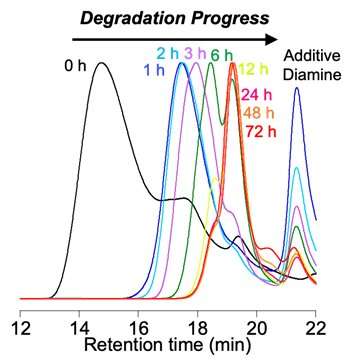This article has been reviewed according to Science X's editorial process and policies. Editors have highlighted the following attributes while ensuring the content's credibility:
fact-checked
peer-reviewed publication
trusted source
proofread
Novel high refractive index polymers show promise in sustainable optoelectronics

High refractive index polymers (HRIPs) are essential for manufacturing modern optoelectronic devices, including displays and light sensors. However, high-performance HRIPs are expensive and environmentally unfriendly.
Recently, a research team from Waseda University developed a new family of HRIPs called poly(thiourea)s. Thanks to unique intermolecular interactions, these compounds can be easily processed into low-cost transparent HRIPs for optoelectronic applications, as well as degraded and recycled through an inexpensive protocol, making them a sustainable option.
Optoelectronic devices have found their way into many aspects of our daily lives, from OLED displays to photodetectors, security systems, and environmental monitoring. In all the applications, these devices utilize high refractive index polymers (HRIPs) to control light.
In general, the optical properties of transparent HRIPs enable efficient light transmission and manipulation, allowing optoelectronics devices to guide and control the flow of light to improve their performance.
However, there are no low-cost options for HRIPs that can guarantee good optical performance while being transparent and environmentally friendly. This is because, for most materials, there exists an inherent trade-off between their refractive index, transparency, and processability.
A research team led by Professor Kenichi Oyaizu from the Department of Applied Chemistry at Waseda University, Japan, found a way to circumvent this problem. In their article published in Advanced Functional Materials, the researchers report a novel type of aromatic HRIP whose properties make it a perfect candidate for modern optoelectronic applications.
This article was co-authored by Seigo Watanabe from the Research Institute of Science and Engineering, Waseda University, as well as Luca M. Cavinato and Rubén D. Costa, both from the Chair of Biogenic Functional Materials, Technical University of Munich, Germany.
-

Researchers report a novel family of low-cost, sustainable polymers that could be useful for modern displays, photodetectors, and lighting devices. Credit: Kenichi Oyaizu from Waseda University -

a) Molecular design of poly(thiourea)s (PTUs) with polarizable group synergy, b) plausible schematic representation of disordered (various conformational) H-bonding networks between the PTU chains enabling polarizable supramolecular networks, and c) schematic representation of the architecture of light-emitting electrochemical cells. Credit: Kenichi Oyaizu from Waseda University -

Researchers establish a very inexpensive protocol to convert the proposed polymers into monomers that can be reused for other chemical synthesis procedures. Consisting of only mild heating and the addition of diamine, this protocol ensures the proposed family of compounds is compatible with current sustainability goals. Credit: Kenichi Oyaizu from Waseda University
The proposed family of compounds are called poly(thiourea)s (PTUs), with each repeating unit of the polymer (the monomer) comprising a simple aromatic ring linked to a thiourea group (H2N−C(=S)−NH2). These PTUs have an exceptional property: the thiourea units in different polymer strands attract each other via hydrogen bonds, which is a type of intermolecular interaction.
Simply put, the sulfur (S) atoms of a thiourea group attract the hydrogen (H) atoms linked to nitrogen (N) in another thiourea group due to local differences in electric charge.
These so-called "polarizable hydrogen bonds" cause the PTU material to be densely packed, creating dense networks. Since the polymer is amorphous and has no crystalline order, it is highly transparent. Meanwhile, the aromatic rings serve as spacers, providing some rigidity and mechanical strength and contributing to a higher refractive index.
The research team carefully analyzed the properties of these PTUs and demonstrated their potential by incorporating them into experimental optoelectronic components, obtaining remarkable results. More specifically, the proposed PTUs demonstrated a high transparency of over 92% and an exceptional refractive index of 1.81.
Notably, the team also investigated whether PTUs could be easily degraded into simpler useful molecules.
"Due to recent environmental issues caused by plastic wastes, the degradation of polymers to monomers becomes an essential functionality leading to sustainable recycling. To the best of our knowledge, there have been extremely few attempts to impart degradability to HRIPs, and systematic designs for degradable HRIPs have not been reported despite such global needs," says Prof. Oyaizu.
Their efforts led to a simple degradation protocol that involves mild heating conditions and mixing with diamines, which is enough to break up PTUs into smaller pieces that can be reprocessed or repurposed for the chemical synthesis of new PTUs.
Overall, the results of this study are very promising for the future of optoelectronic materials and devices in the greater context of sustainability.
"Based on these findings, environmentally friendly optical materials would be easily preparable with a simple process, enabling sustainable optoelectronics such as low-cost bright displays, wearable lighting devices, and thinner, lighter, and degradable polymer eyeglasses," concludes Prof. Oyaizu.
"I believe this is the first step toward the comprehensive design of next-generation optoelectronic polymers that can provide high light-extraction efficiency without harming the environment."
More information: Seigo Watanabe et al, Polarizable H‐Bond Concept in Aromatic Poly(thiourea)s: Unprecedented High Refractive Index, Transmittance, and Degradability at Force to Enhance Lighting Efficiency, Advanced Functional Materials (2024). DOI: 10.1002/adfm.202404433
Journal information: Advanced Functional Materials
Provided by Waseda University




















